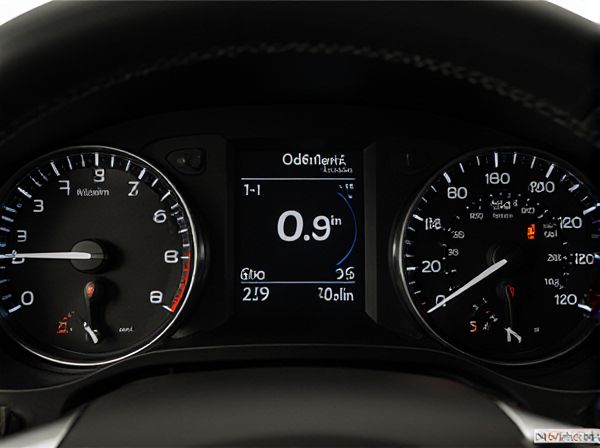
Photo illustration: Trip Computer Display vs Standard Odometer
A trip computer display provides detailed information such as distance traveled, average speed, fuel consumption, and estimated range, offering real-time data to enhance your driving experience. In contrast, a standard odometer simply tracks the total distance your vehicle has traveled without additional insights. Choosing a trip computer empowers you to monitor and optimize your vehicle's performance more effectively than relying solely on a basic odometer.
Table of Comparison
| Feature | Trip Computer Display | Standard Odometer |
|---|---|---|
| Function | Shows trip distance, fuel efficiency, average speed, and travel time | Displays total vehicle mileage only |
| Data Precision | Detailed and real-time trip metrics | Cumulative distance without trip-specific data |
| Driver Benefits | Optimizes fuel consumption and trip planning | Basic mileage tracking for maintenance |
| Reset Capability | Resettable per trip or journey | Non-resettable, continuous total mileage |
| Display Type | Digital, multi-information interface | Analog or digital, single metric |
Introduction to Vehicle Data Displays
Vehicle data displays like the trip computer and standard odometer provide essential driving information directly on the dashboard. The trip computer offers detailed metrics such as trip distance, average speed, and fuel consumption, enhancing driver awareness and efficiency. In contrast, the standard odometer measures the total distance traveled by the vehicle, serving as a fundamental tool for maintenance and resale valuation.
What is a Trip Computer Display?
A Trip Computer Display is an advanced vehicle interface that provides real-time data such as average speed, fuel consumption, distance traveled, and estimated remaining range, enhancing driving efficiency. Unlike a Standard Odometer that solely records total miles or kilometers driven, the Trip Computer offers detailed and dynamic information to assist with trip planning and fuel management. Modern vehicles equipped with trip computers improve driver awareness and contribute to cost savings by optimizing driving habits.
Understanding the Standard Odometer
The standard odometer measures the total distance a vehicle has traveled since its manufacture, providing crucial data for maintenance schedules and resale value assessment. Unlike the trip computer display, which offers customizable trip distances and average fuel consumption, the standard odometer presents a cumulative mileage reading that cannot be reset. Accurate standard odometer readings are essential for tracking long-term vehicle usage and ensuring compliance with legal requirements in automotive record-keeping.
Key Features of Trip Computer Displays
Trip computer displays provide comprehensive driving data including real-time fuel consumption, average speed, and estimated range, far beyond the basic distance measurement of standard odometers. Key features include customizable trip timers, instantaneous and average mileage readouts, and detailed maintenance alerts that enhance vehicle management. This advanced functionality improves fuel efficiency monitoring and trip planning, offering drivers precise and actionable information compared to traditional odometer-only readings.
Limitations of Traditional Odometers
Traditional odometers measure only the total distance traveled, lacking real-time trip-specific data and precise fuel consumption metrics. They offer no breakdown of partial journeys, making it difficult to monitor individual trip distances or calculate accurate fuel efficiency. Unlike trip computer displays, standard odometers do not provide important insights like average speed, elapsed time, or navigation assistance, limiting their usefulness for detailed travel analysis.
Accuracy: Trip Computer vs Odometer
Trip computer displays provide highly accurate, real-time data on distance traveled by using GPS and sensor inputs, which adjust dynamically to driving conditions. Standard odometers rely on mechanical or electronic wheel rotations, making their accuracy dependent on tire size and wear, potentially leading to slight measurement discrepancies. Trip computers offer superior precision for monitoring travel distances compared to standard odometers, especially during complex driving scenarios.
Additional Data Provided by Trip Computers
Trip computer displays provide extensive additional data beyond the standard odometer's basic mileage count, including real-time fuel consumption, average speed, and estimated range based on current fuel levels. These enhanced metrics help drivers optimize fuel efficiency and plan long trips more effectively. Unlike standard odometers that only track total distance traveled, trip computers offer dynamic insights for a comprehensive driving analysis.
Ease of Use and Readability
Trip computer displays offer enhanced ease of use and readability compared to standard odometers by providing digital screens that clearly show real-time data such as distance traveled, fuel efficiency, and estimated range. The larger, backlit interfaces on trip computers improve visibility in various lighting conditions, reducing eye strain and allowing drivers to monitor multiple metrics at a glance. Standard odometers typically feature a simple, mechanical or basic digital readout focused solely on total mileage, limiting the amount of information available and requiring more effort to interpret while driving.
Maintenance and Reliability Comparison
Trip computer displays provide detailed real-time information such as fuel efficiency, distance to empty, and average speed, enhancing vehicle maintenance by allowing drivers to monitor performance trends more accurately than standard odometers. Standard odometers only track total distance traveled, offering limited insight into maintenance needs, potentially leading to overlooked service intervals. Reliance on trip computer data promotes proactive maintenance and improves reliability by alerting drivers to anomalies early, which standard odometers alone cannot do.
Choosing the Right Display for Your Needs
Selecting between a trip computer display and a standard odometer depends on your specific driving needs and preferences. A trip computer offers comprehensive data such as fuel efficiency, trip distance, and average speed, enhancing route planning and fuel management. In contrast, a standard odometer provides basic mileage tracking, suitable for drivers who prioritize simplicity and essential vehicle monitoring.
 caratoz.com
caratoz.com